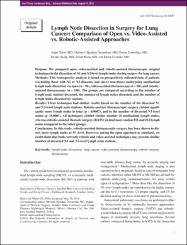Lymph node dissection in surgery for lung cancer: Comparison of open vs. video-assisted vs. robotic-assisted approaches

View/
Access
info:eu-repo/semantics/openAccessDate
2016Author
Toker, AlperÖzyurtkan, Mehmet Oğuzhan
Demirhan, Özkan
Ayalp, Kemal
Kaba, Erkan
Uyumaz, Elena
Metadata
Show full item recordCitation
Toker A, Ozyurtkan MO, Demirhan O, Ayalp K, Kaba E, Uyumaz E. Lymph Node Dissection in Surgery for Lung Cancer: Comparison of Open vs. Video-Assisted vs. Robotic-Assisted Approaches. Ann Thorac Cardiovasc Surg. 2016. doi: 10.5761/atcs.oa.16-00087Abstract
Purpose: We compared open, video-assisted and robotic-assisted thoracoscopic surgical techniques in the dissection of N1 and N2-level lymph nodes during surgery for lung cancer.
Methods: This retrospective analysis is based on prospectively collected data of patients (excluding those with N2 or N3 diseases, and sleeve resections) undergoing mediastinal lymph node dissection via open (n = 96), video-assisted thoracoscopy (n = 68), and robotic-assisted thoracoscopy (n = 106). The groups are compared according to the number of lymph node stations dissected, the number of lymph nodes dissected, and the number of lymph nodes dissected by stations.
Results: Three techniques had similar results based on the number of the dissected N1 and N2-level lymph node stations. Robotic-assisted thoracoscopic surgery yielded significantly more lymph nodes in total (p = 0.0007), and in the number of dissected N1-level nodes (p <0.0001). All techniques yielded similar number of mediastinal lymph nodes, whereas robotic-assisted thoracic surgery (RATS) yielded more station #11 and #12 lymph nodes compared to the other groups.
Conclusions: In this study, robotic-assisted thoracoscopic surgery has been shown to dissect more lymph nodes at N1 level. However, taking the open approach as standard, we could claim that both currently robotic and video-assisted techniques may provide similar number of dissected N1 and N2-level lymph node stations.
Source
Annals of Thoracic and Cardiovascular SurgeryURI
https://hdl.handle.net/11446/1080https://www.jstage.jst.go.jp/article/atcs/advpub/0/advpub_oa.16-00087/_article

















